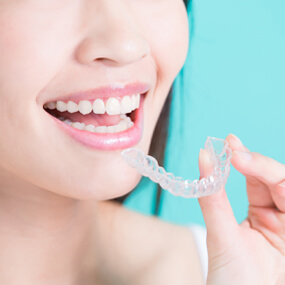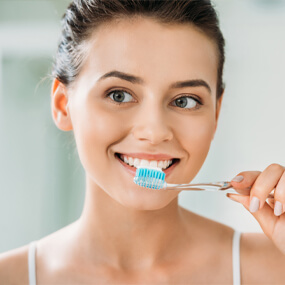A Guide to Proper Brushing and Flossing

Positive oral health is inextricably linked to good overall health and high quality of life. Maintaining good oral health is rather simple, but many people get the basics—like brushing and flossing—wrong.
Brushing Your Teeth for Good Oral Health
Plaque is a fact of human life. Whenever we eat or drink carbohydrates, those compounds are mixing with bacteria and your saliva to create plaque. Plaque releases acids, which erode your tooth enamel, and hardens into tartar, often in as little as 24 hours. Plaque is sticky and accumulates on teeth and gums, and it leads to cavities as well as gum disease. Removing plaque regularly is imperative.
The American Dental Association (ADA) recommends that you brush once in the morning after breakfast and again at night before you go to bed. You should also:
- Brush for at least two minutes at a time. Avoid rushing. Be gentle. Be detail-oriented. Use circular motions on every exposed side of every tooth. Avoid brushing right after eating. Wait 30 minutes or so. Be sure to brush your tongue as well, or use a tongue scraper.
- Use a soft-bristled brush and toothpaste with fluoride. All the products you choose should have the ADA Seal of Acceptance. A small brush head is more comfortable and easier to use. A powered toothbrush is optional, but they often make the task easier and the results more consistent.
- Practice good technique. It will eventually become second nature. Hold the toothbrush at an angle. Aim the bristles toward where the tooth and gums meet. You can move the brush in a circular or back-and-forth motion. The key is to cover the entire surface with each stroke.
- Maintain your equipment. Sanitize your brush once a week using hydrogen peroxide. Rinse your brush thoroughly after every use. Replace your toothbrush or brush head after three months or as soon as any signs of wear are visually evident. Replace your toothbrush after an illness.
- Store your toothbrush in an upright position. After rinsing, allow it to air dry before using it again. Do not store toothbrushes together to avoid cross-contamination. Avoid storing toothbrushes in closed containers that can encourage the growth of bacteria, mold, and so forth.
Flossing Your Teeth for Good Oral Health
Plaque accumulates in places you cannot reach with your toothbrush, such as between the teeth and between the teeth and gums. The ADA recommends that you floss once a day. Be mindful that tartar can form in just 24 hours, but there is no need to floss more frequently. You should:
- Use about 18 inches of dental floss. Most of that floss should be wrapped around the middle finger of one hand and then the middle finger of the other. Grip the floss between thumb and forefinger.
- Be gentle. You can damage your gums, and there is no need to floss hard. When you get to the gumline, curve the floss against the tooth in order to form a C-shape.
- Floss one tooth at a time. Gently rub the side of each tooth as you move the floss up and down. Do this between the tooth and gum as well. Unwind the floss as needed as you progress.
- Consider floss alternatives. Conventional floss is perfectly fine, but many people prefer pre-threaded flossers for convenience. You can also use a water flosser or a dental pick, but you may want to discuss these options with your dentist before making a decision.
- Feel free to brush first or floss first. Either way is fine.
Other Dental Care Tips
- The ADA recommends using a therapeutic mouth rinse once a day.
- You should rinse your teeth vigorously with water after lunch, dinner, and snacks.
- Avoid using toothpicks as they can easily injure your gums. You can use dental floss as needed to dislodge food particles that are stuck between your teeth.
- Quit smoking! This goes without saying. Tobacco is bad for you. Not only does it lead to cancer, but it really does a number on your teeth and gums, and that damage does not take long at all.
Visiting Your Dentist
Great oral hygiene starts at home, but you need to see your dentist on a regular basis. Your dentist can scrape away any tartar and examine your mouth for any potential problems. The ADA recommends an annual visit at a minimum, and most dental professionals advise biannual visits. You should also schedule a visit with your dentist right away if you notice any of the following warning signs:
- Painful chewing
- Loosening or shifted teeth
- Red, tender, or swollen gums
- Unusual sensitivity to cold or heat
- Gums that are receding from your teeth
- Persistent halitosis or frequent unusual tastes
- Gums that bleed easily when you brush or floss
Early detection is vital to ensuring good oral health throughout your life and avoiding high dental costs. This is why preventative dental care on a consistent basis is so important!
Protect Your Teeth and Gums
Brush twice a day, floss daily, and see your dentist twice a year! Jeffrey D. Clark, DDS, provides all the preventative dental care you need as well as leading-edge cosmetic and restorative treatments. Dr. Clark can provide you personalized oral hygiene advice as well as work with you on a plan to perfect your smile and maintain it that way throughout your life. Call Scottsdale Cosmetic Dentistry Excellence today at 480 585 1853 to schedule your appointment.




